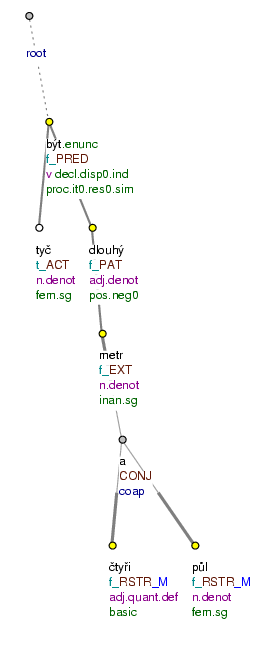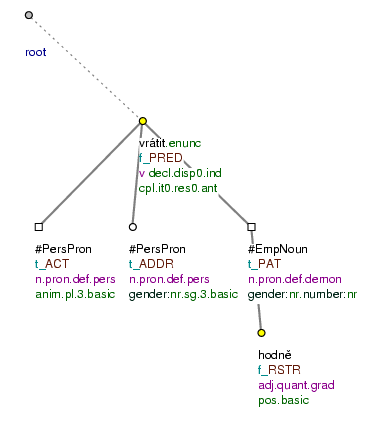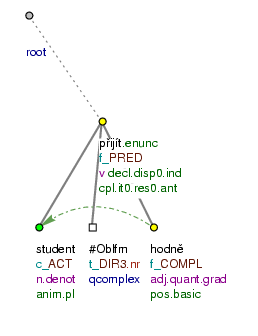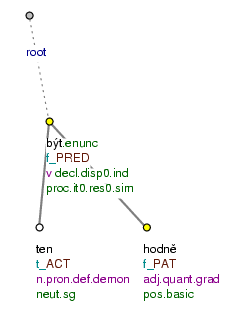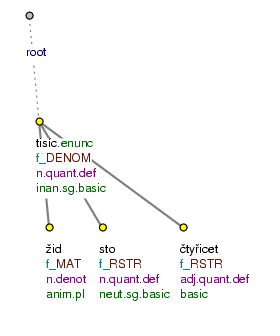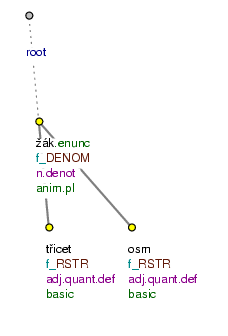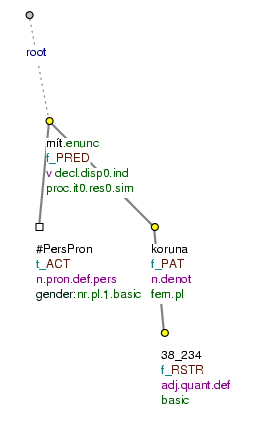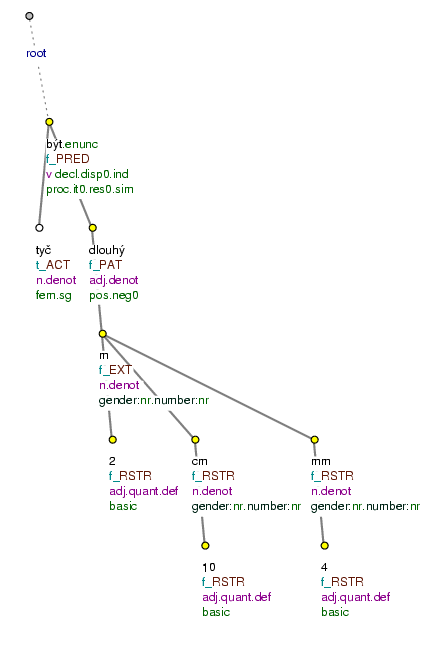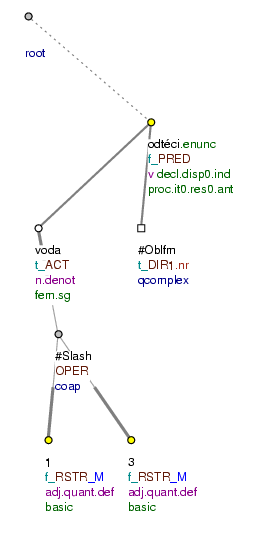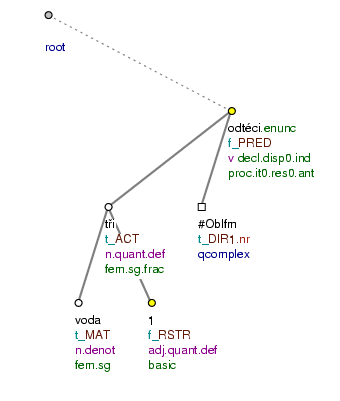10.2.1. Competition of a numeral with the attributive function and one with the meaning of a "container"
If a counted object is modified by two (or more) numerals in coordination or apposition, one of which should be assigned the functor RSTR (following the rules in Section 10.1.1, "Numerals with the role of an attribute (RSTR)") and the other one has the meaning of a container (see Section 10.1.2, "Numerals with the meaning of a "container""), then, both (all) nodes representing the numerals depend on the node for the counted object. Both (all) nodes get the RSTR functor.
Examples:
Tyč je dlouhá čtyři.RSTR a půl.RSTR metru. (=The pole is four and a half meters long) Fig. 8.188
Pracují už dvě.RSTR a čtvrt.RSTR hodiny. (=They have already worked for two and a quarter hours)
Mám tisíc.RSTR a jeden.RSTR důvod ti nevěřit. (=I have one thousand and one reasons not to believe you)
NB! This type is to be distinguished from the type pět milionů lidí (=five million people) where the numerals do not compete. See also Section 10.1.2, "Numerals with the meaning of a "container"".
Adverbial meanings (see Section 10.1.4, "Numerals with adverbial meanings"). Numeral expressions hodně (=a lot), dost (=enough), moc (=much), málo (=little), plno (=plenty), stejně (=equally / to_the same_degree) (and their comparative forms více (=more), méně (=less)) have usually adverbial functions (they are mostly assigned the functor EXT).
Examples:
Hodně.EXT mě zajímalo, jak to funguje. (=I was interested a lot in knowing how it works) Fig. 8.189
Musel se chovat hodně.EXT opatrně (=He had to behave very cautiously).
Polévka je málo.EXT slaná (=The soup is not salty enough).
Attributive function (see Section 10.1.1, "Numerals with the role of an attribute (RSTR)"). When combined with a counted noun, the numerals hodně, dost, moc, málo, plno, stejně (and their comparative (and superlative) forms více, méně) have the adjectival function. The node representing a numerals like these depends on the node for the counted noun and has the RSTR functor. If the counted object (the governing noun) is not present at the surface level, a new node is inserted in its position in the tectogrammatical tree, following the rules in Section 12.1.2, "Ellipsis of the governing noun".
Examples:
Vrátili mu hodně.RSTR {#EmpNoun.PAT} . (=They returned him a lot) Fig. 8.190
Mám toho.PAT dost.RSTR (=I've got enough) (dost depends on toho)
Vydělá víc.RSTR {#EmpNoun.PAT} (=He earns more)
Vydělá stejně.RSTR {#EmpNoun.PAT} jako vloni. (=He is going to earn the same (money) as last year)
Dostal méně.RSTR {#EmpNoun.PAT} (=He got less)
NB! When the numerical expression is in the position of the Patient or Effect and agrees with another valency modification (this is a traditional predicative complement), when it is in the position of a predicative complement or the nominal part of a verbonominal predicate, no new node for the counted noun is inserted (see also Section 10.1.1, "Numerals with the role of an attribute (RSTR)").
Examples:
Studentů přišlo hodně.COMPL (=lit. Students came many) Fig. 8.191
To je hodně.PAT (=This is a lot) Fig. 8.192
Festivalových filmů existuje jen málo.COMPL (=lit. Festival movies exist only few)
Peněz mu vrátili hodně.COMPL (=lit. Money (they) him returned a lot)
Studentů přišlo více.COMPL (=lit. Students came more)
Děvčat je málo.PAT (=lit. Girls are few)
To je moc.PAT (=This is too much)
To je o důvod víc.PAT (=This is one reason more)
NB! A special rule is applied in comparative constructions in which quantities are compared (see Section 4.2.1, "Comparing quantities by means of the conjunction "než"").
Figure 8.189. The numeral hodně as an adverbial
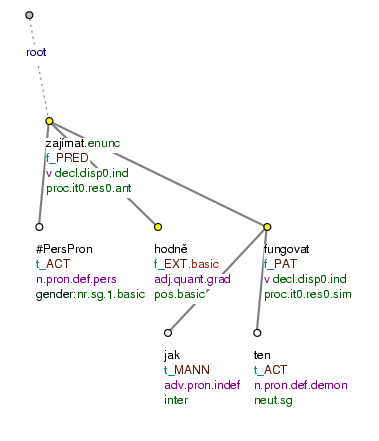
Hodně mě zajímalo, jak to funguje. (=lit. A_lot me interested how it works)
Complex numerical expressions of the type sto čtyřicet tisíc (=one hundred and forty thousand), dva miliony pět set tisíc (=two million five hundred thousand), třicet osm (=thirty-eight) are not assigned any inner structure:
-
if a complex numerical expression contains one or more numerals with the meaning of a container, the numeral with the highest numerical value is analyzed as the governing node of the whole numerical expression. The governing node of a complex numerical expression is assigned a functor corresponding to its position in the structure. The nodes representing all the other parts of the numerical expression depend on the governing node (they are sisters w.r.t. each other) and are assigned the
RSTRfunctor. The node representing the (possible) counted object has theMATfunctor and depends on the governing node of the complex numerical expression.Examples:
sto.
RSTRčtyřicet.RSTRtisíc židů.MAT(=one hundred and forty thousand Jews) Fig. 8.193Vydělal dva.
RSTRtisíce.PATčtyři.RSTRsta.RSTRpět.RSTRkorun.MAT(=He earned two thousand four hundred and five crowns)Žije zde jeden.
RSTRmilion.ACTpět.RSTRset.RSTRtisíc.RSTRlidí.MAT(=One million five hundred thousand people live here) -
if there is no numeral with the meaning of a container in the complex numerical expression, the governing node of the expression is the node for the counted object and all the other parts of the expression depend on the governing node (they are sister w.r.t. each other) and are assigned the
RSTRfunctor.Examples:
třicet.
RSTRosm.RSTRžáků (=thirty-eight pupils) Fig. 8.194Vydělal dvacet.
RSTRpět.RSTRkorun.PAT(=He earned twenty-five crowns)Žije zde šedesát.
RSTRdva.RSTRlidí.ACT(=Sixty-two people live here)
Numerals written in digits. If a numerical expression is written in digits, it is assigned a single node.
Examples:
Mám 38 234.RSTR korun.PAT (=I've got 38 234 crowns) Fig. 8.195
Mám 38 234.PAT (=I've got 38 234)
Vydělal 2 405.RSTR korun.PAT (=He earned 2 405 crowns)
Žije zde 1 500 000.RSTR lidí.ACT (=1 500 000 people live here)
Žije zde 1 500 000.ACT (=1 500 000 (people) live here)
Numerical expressions that are combinations of numerals and physical units, i.e. expressions of the type 2 m 10 cm 4 mm, 1 h 20 min are not assigned any inner structure. The governing node of the expression is the physical unit with the highest value. The governing node of the numerical expression is assigned a functor corresponding to its position in the structure. The nodes for the other physical units depend on the governing node (they are sisters w.r.t. each other) and get the RSTR functor; the nodes for the numerals depend on their respective nodes for the physical units and get the RSTR functor, too.
Examples:
Tyč je dlouhá 2 m.EXT 10 cm 4 mm. (=The pole is 2m 10cm 4mm long) Fig. 8.196
Film začíná ve 2 hod.TWHEN 35 min. (=The film begins at (lit.) 2h 35 min) (The following case is different: Film začíná ve 2 hod.TWHEN a 35 min.TWHEN (=The film begins at (lit.) 2h and 35 min))
Vážil 53 tun.EXT 15 kg. (=It weighed 53t 15 kg) (The following case is different: Vážil 53 tun.EXT a 15 kg.EXT (=It weighed 53t and 15kg))
NB! The rules as described above do not concern forms like 7: 30, which are analyzed (as paratactic structures) with the help of the OPER functor (see Section 11, "Mathematical operations and intervals"), and forms like dne 3. února roku 2003 (=on 3 February 2003), 3. 2. 2003 e.t.c., which are assigned inner structure (see Section 12.10, "Set expressions in journalism" and Section 11.3, "Mutual relation of two or more locative/directional or temporal modifications").
NB! Expressions of the type 40procentní (=40%.adj), 20metrový (=20m.adj) are represented by a single node with a t-lemma of the form: 40_procentní, 20_metrový (see Section 3.1, "Multi-word t-lemma").
Decimals. Decimal numbers (written in digits) are represented as a single node and get a functor depending on their position in the structure.
Examples:
Výroba se zvýšila o 2,3.RSTR procenta. (=The production increased by 2.3 per cent)
Výstavu navštívilo 2,5.RSTR tisíc lidí. (=2.5 thousand people visited the exhibition)
Fractions. Fractions written in digits (with a slash) are analyzed with the help of the OPER functor (see Section 11, "Mathematical operations and intervals"), i.e. like paratactic structures. If a fraction is written in words, the rules described above are followed (especially Section 10.1.2, "Numerals with the meaning of a "container"").
Examples (fraction in digits):
1 / 3 vody odtekla. [#Slash.OPER] (=one third of the water flew off) Fig. 8.197
1 / 2 práce už je za námi. [#Slash.OPER] (=half of the work is over already)
Examples (fraction written in words):
1.RSTR třetina.ACT vody.MAT odtekla. (=one third of the water flew off) Fig. 8.198
1.RSTR polovina.ACT práce.MAT už je za námi. (=half of the work is over already)
